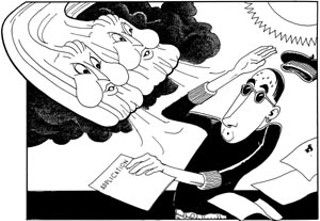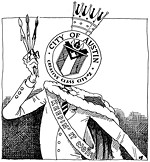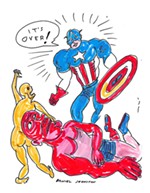Change in the Weather
A different kind of summer for the city arts funding process
By Robert Faires, Fri., Sept. 3, 2004

Summer in Austin traditionally means a painfully long run of broiling, 100-degree days and a similarly protracted string of blistering attacks on the city's Cultural Contracts program. In years past, the panels evaluating applicants for city arts funding and the moneys allocated to those applicants by the Austin Arts Commission have sparked howls of criticism, accusations of unfairness, and charges of conflict of interest that could be heard from June through the city budget deliberations of September.
But just as 2004 has shown Austin a summer that may be called mild compared with previous years, it's also shown us a summer in which the usual overheated squalls over city arts funding have been relatively calm. It's been so quiet on the arts scene, you could hear crickets chirp.
Maybe those cool fronts in July deserve some credit, but the chief reason for this radical change in the cultural weather is the change in the arts funding process itself. When Cultural Arts Program Manager Vincent Kitch was hired last fall, his first mission was to clean up the city's messy method of funding the arts. After five intense months of study, history lessons, and conversations with just about everyone who had an opinion on the matter, Kitch proposed an overhaul that would reorganize applicants by size and purpose as well as by artistic discipline, employ more peer review panelists from out of town and pay them a stipend for their services, score applications by established evaluation criteria that would apply across all disciplines, and remove the ranking of applicants and direct recommendations of funding from the review panels. Funding would ultimately be determined using mathematical formulas based on policies developed by the Arts Commission, the amount of money available, and the score of the applicant.
When we last left the arts community ("It's a Dirty Job," April 16, 2004), its members were viewing these proposed reforms with guarded optimism. They certainly sounded like improvements, and everyone wanted them to work, but after being beaten and bruised by this process for so long, applicants couldn't help but be wary. Still, as the summer progressed, many of the old problems just didn't crop up. No applications disqualified over technical violations. No butting of heads by multimillion-dollar institutions and shoestring companies in the same disciplinary panels. No tense face-offs between applicants and panelists during the panel reviews. No mystifying rankings of applicants that seemed to reward emerging artists and groups at the expense of established ones (or vice versa). No conflict-of-interest battles. No five-hour public hearings with the Arts Commission.
The program seemed to be working.
What made the difference, for starters, was the drawing of some simple lines of separation: between applicants and panelists, between applicant and applicant. Eliminating applicants' appearances before panelists took away that arena of confrontation – where personality and personal attitudes sometimes muddied the waters of evaluation – and let both sides focus on the case for funding made in the application. A code of conduct spelled out more clearly than ever what constituted conflicts of interest for panelists and that they had to leave a review session while an application by an organization or artist with whom they had a conflict was considered.
New lines separated applicants by size and kind of support, removing the awkward comparisons of so-called "major" and "minor" arts groups that stood cheek to jowl in the old days. Now, larger cultural organizations had a category for institutional support, midsize groups and established artists had a category for projects up to $50,000, while emerging groups and individual artists had a category for support of projects up to $10,000 and one for training and professional development up to $1,000.
Actually, though, new lines separated every applicant from every other applicant. The ranking that caused so much rancor through the years was dispatched for a scoring system in which each applicant is evaluated independently against a set standard instead of against his peers (some of whom may be bigger, richer, or maybe just possessed of more flair).
All these lines neatly reorganized the funding process so that areas that had grown so messy and contentious were orderly, discrete, and less prone to being abused by participants. Even so, it was humans still running the show, and unless they applied the procedures fairly, all the reforms would have been for naught.
Fortunately, the city managed to secure panelists who were knowledgeable, professional, and commited to the work, artists such as Austin Arts Hall of Famer Gina Lalli, musician Natalie Zoe, and Rude Mechs co-Artistic Director Shawn Sides, and administrators such as Ballet Austin Managing Director Cookie Ruiz and, from out of town, Jump-Start Performance Company Executive Director Steve Bailey and Maria Muñoz-Blanco, executive director for the Cultural Arts Council of Houston and Harris County. The 45 panelists (26 from Austin, 19 from elsewhere in the state) fielded 13 panels – many doing double duty – and reviewed 198 applications between July 14 and Aug. 14.
Most panels managed to conclude their work in just a few hours, not because they rushed but because the panelists were well-prepared. Some spent as many as 30 hours in advance studying each 10-page application and supplementary materials (e.g., promotional pieces, videotapes, résumés, reviews). For the first time, panelists were assigned to serve as primary and secondary readers for applications, giving their fellow panelists overviews of the application and the applicants' work, and many delivered elaborate, in-depth analyses. After such preparation, relatively little discussion was needed for the average application. As Mike Meilinger, a longtime applicant who served as a panelist for the first time this year, put it, "Once you've spent 20-25 hours going through the applications – reading, making notes, scoring – you've kind of made up your mind to a certain extent." Meilinger says that the community initiatives panel he sat on started at 10am and breezed through 17 applications by 12:15pm.
Throughout the summer, Vincent Kitch, who had vowed to serve as point man in this crucial transition year, proved as good as his word. He met with council aides to familiarize them with the new system. He facilitated all 13 panel reviews. He took the results to the Arts Commission on Aug. 23 and two days later hit an Austin Arts Coalition meeting to address the questions and concerns of arts community members. He's set to meet with council members to update them on the program's progress and share the results of surveys filled out by applicants and panelists after their participation in the program this summer. (According to Kitch, those results are overwhelmingly positive.)
Of course, he didn't pull this off alone, and he's quick to credit Cultural Arts Program staff for their hard work this year, extending extra assistance to applicants so that their requests for support would be as complete as possible.
Procedures were followed. People behaved. Feedback says thumbs are up. So is all finally well in the Cultural Contracts Program? Is it 72-degree summers from now on?
Hardly.
The idea of being unable to speak during the panel reviews is coming in for some knocks from applicants who weren't allowed to correct erroneous comments made about their applications in a panel review. And there's some dissatisfaction over the release of the panel results, which aren't being made available yet.
But the big problem that isn't addressed by the reforms and that's likely to bring back the squalls of old is a serious reduction in funding. The hotel/motel tax, from which all city arts funding is drawn, dropped this year to the tune of $500,000. From last year's $3 million-plus, that's a steep drop, especially considering the funding requests total $6,725,803. While the new system's combination of scoring and mathematical formula makes for a fairer distribution of funds to applicants who score well, it still means that more applicants could be getting a much smaller chunk of cash than they requested – an echo of the painful across-the-board cuts of recent years – or, if the cut-off line for funding is raised to a score of 75, 80, or higher, some applicants might wind up with more cash, but more would receive no funding at all this year. In either case, the pain could be serious enough to inspire applicants to revive the old back-door appeal to council for funds.
Oh well, anyone who's lived here for any time knows that a cold front in summer can't last long. That said, no one promised a perfectly reformed process the first time out. Kitch made it clear that this year would be a test and that it would be followed by a year of evaluation and change. Participants from this year's process are already being lined up for committees to evaluate the system and reform the reforms. Those surveys with comments from applicants and panelists are being studied. And Kitch already plans to back up the process deadlines, giving applicants, staff, and himself more time than they had this year to move through the process with care. All that's to say, sure, it may get hot again, but the winds of change are still blowing. ![]()









